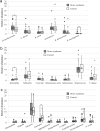Characterization of the unique oral microbiome of children with Down syndrome
- PMID: 35986204
- PMCID: PMC9391446
- DOI: 10.1038/s41598-022-18409-z
Characterization of the unique oral microbiome of children with Down syndrome
Abstract
Down syndrome creates an abnormal oral environment, including susceptibility to periodontal disease at a young age, but there are no detailed studies of the oral microbiome in children with Down syndrome. In this study, we performed a comprehensive analysis of the oral bacteria of 40 children with Down syndrome and 40 non-Down syndrome children. Microbial DNA was extracted from dental plaque specimens and the V4 hypervariable region of the bacterial 16S rRNA gene was analyzed using the MiSeq platform. There were significant differences between the Down syndrome and non-Down syndrome groups in mean numbers of operational taxonomic units, and α- and β-diversity (P < 0.05). Interestingly, significant differences in α- and β-diversity between the two groups were only observed in subjects with gingival inflammation, but not in those without gingival inflammation (P < 0.05). Taxonomic analysis at the genus or species levels showed significant differences in relative abundance levels of certain bacteria between the Down syndrome and non-Down syndrome groups, including Corynebacterium, Abiotrophia and Lautropia (P < 0.05). These results suggest that children with Down syndrome may have a unique oral microbiome that could impact the development of dental diseases common in people with the syndrome.
© 2022. The Author(s).
Conflict of interest statement
The authors declare no competing interests.
Figures





References
Publication types
MeSH terms
Substances
LinkOut - more resources
Full Text Sources

